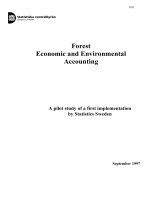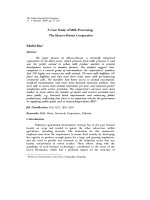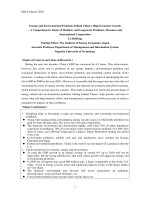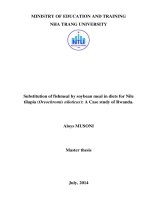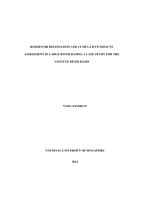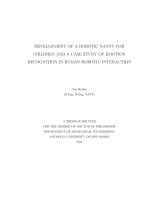A security study of two non tomographic quantum communication protocols
Bạn đang xem bản rút gọn của tài liệu. Xem và tải ngay bản đầy đủ của tài liệu tại đây (2.44 MB, 300 trang )
A SECURITY STUDY OF TWO
NON-TOMOGRAPHIC QUANTUM
COMMUNICATION PROTOCOLS
SYED MUHAMAD ASSAD
NATIONAL UNIVERSITY OF SINGAPORE
2010
A SECURITY STUDY OF TWO
NON-TOMOGRAPHIC QUANTUM
COMMUNICATION PROTOCOLS
SYED MUHAMAD ASSAD
(B.Sc. (Hons), NUS)
A THESIS SUBMITTED
FOR THE JOINT NUS–ANU DEGREE OF DOCTOR
OF PHILOSOPHY
DEPARTMENT OF PHYSICS
NATIONAL UNIVERSITY OF SINGAPORE
2010
i
Acknowledgements
I would like to thank my principal supervisor Prof. Berthold-Georg Englert at
NUS for his guidance and tireless support throughout my Ph.D. candidature. I
would also like to thank Prof. Lam Ping Koy for his support and for giving me the
opportunity to do part of my research at the ANU.
Thank you, Jun Suzuki, for working with me on the direct communication
protocol. Thank you, Andreas Keil, for your endless enthusiasm in tackling the
most challenging problems.
A special thank you to Nicolai Grosse for your patience in teaching me every-
thing I know about experimental quantum optics. Your ability to find simple and
quick solutions to solve what at first looks like insurmountable problems makes
working with you really fun and enriching.
Thank you to Daniel Alton for the many interesting discussions that we had
in ironing out the problems in the continuous variable key distribution protocol.
Your discipline and drive are very admirable.
Thank you to Thomas Symul, Daniel Alton, Christian Weedbrook and Timo-
thy Ralph for teaching me continuous variable quantum information while I was
at ANU and for allowing me to work on your interesting CVQKD protocol.
ii
Thank you to Michael Stefzky, Moritz Mehmet and Wu Ru Gway for the joint
effort in battling with the experiments we did at the ANU.
Thank you to my colleagues and friends at the NUS: Gelo Tabia, Marta Wolak,
Dario Poletti, Amir Kalev, Philippe Raynal, Chua Wee Kang, Looi Shiang Yong,
Bess Fang, Han Rui, Lu Yin, Teo Yong Siah, Niels Lorch and Daniel Kwan. You
have made my stay at NUS a memorable one.
To my students and to my fellow instructors Nidhi Sharma, Jeremy Chong,
Qiu Leiju and Setiawan, I would like to say thank you for renewing my interest in
physics.
Thank you to Gleb Maslennikov, Tey Meng Khoon, Alexander Ling, Syed
Abdullah and Brenda Chng for accommodating me in the lab when I needed to
get away from the office once in a while.
Thank you to Ben Buchler, Vikram Sharma, Magnus Hsu, Chong Ken Li, Guy
Micklethwait, Katherine Wagner, Zhou Hongxin and Roger Senior who shared the
office with me at the ANU. Thank you for the stimulating discussions, thank you
for the chess games and thank you for generally making my stay at the ANU a
pleasant one.
Thank you Chong Ken Li for sharing with me your expertise on excess noise
in fibres.
I would like to thank Nicolai Grosse and Jun Suzuki again for your many
comments that helped in improving the thesis. I would also like to thank Low
Han Ping for his careful reading of the thesis.
iii
Contents
Acknowledgements i
Contents iii
Abstract xi
List of Tables xiii
List of Figures xv
1 Introduction 1
1.1 Quantum key distribution . . . . . . . . . . . . . . . . . . . . . . 2
1.1.1 BB84 protocol . . . . . . . . . . . . . . . . . . . . . . . 3
1.1.2 Continuous variable key distribution . . . . . . . . . . . . 5
1.2 Information theory . . . . . . . . . . . . . . . . . . . . . . . . . 5
1.2.1 Classical entropy . . . . . . . . . . . . . . . . . . . . . . 6
1.2.2 Von Neumann entropy . . . . . . . . . . . . . . . . . . . 6
1.2.3 Mutual information . . . . . . . . . . . . . . . . . . . . . 7
1.2.4 Accessible information and Holevo quantity . . . . . . . . 9
1.3 Overview of the thesis . . . . . . . . . . . . . . . . . . . . . . . 11
iv
2 Security criteria for quantum key distribution protocols 15
2.1 Quantum states and quantum measurements . . . . . . . . . . . . 16
2.2 Eve’s attacks . . . . . . . . . . . . . . . . . . . . . . . . . . . . 18
2.3 Characterising the channel . . . . . . . . . . . . . . . . . . . . . 19
2.4 Eve’s information for two pure states . . . . . . . . . . . . . . . . 20
2.4.1 Accessible information for two pure states . . . . . . . . . 21
2.4.2 Holevo quantity for two pure states . . . . . . . . . . . . 23
2.5 Classical post-processing . . . . . . . . . . . . . . . . . . . . . . 24
I Security analysis of a quantum direct communication pro-
tocol in the presence of unbiased noise 27
3 Introduction to the protocol 29
3.1 Introduction . . . . . . . . . . . . . . . . . . . . . . . . . . . . . 29
3.2 The protocol . . . . . . . . . . . . . . . . . . . . . . . . . . . . . 30
3.2.1 Example of the protocol . . . . . . . . . . . . . . . . . . 32
3.3 Experimental setup . . . . . . . . . . . . . . . . . . . . . . . . . 34
3.4 Discussions on direct communication . . . . . . . . . . . . . . . 39
4 Noise 1: Intercept and resend strategies 43
4.1 Introduction . . . . . . . . . . . . . . . . . . . . . . . . . . . . . 44
4.2 A simple but biased intercept and resend attack . . . . . . . . . . 45
4.3 Unbiased noise . . . . . . . . . . . . . . . . . . . . . . . . . . . 47
4.3.1 Unbiased attack with noise level of ε = 2/3 . . . . . . . . 50
4.3.2 A slightly more general unbiased attack with noise level
of ε ≥ 2/3 . . . . . . . . . . . . . . . . . . . . . . . . . . 52
v
4.4 Alice and Bob’s mutual information for unbiased noise . . . . . . 54
5 Noise 2: General eavesdropping strategies 55
5.1 Alice–Bob channel . . . . . . . . . . . . . . . . . . . . . . . . . 56
5.2 Alice measures protocol . . . . . . . . . . . . . . . . . . . . . . 57
5.3 When there is noise . . . . . . . . . . . . . . . . . . . . . . . . . 59
5.3.1 The eavesdropper . . . . . . . . . . . . . . . . . . . . . . 60
5.3.2 Eve’s purification . . . . . . . . . . . . . . . . . . . . . . 62
5.3.3 Eve’s input states . . . . . . . . . . . . . . . . . . . . . . 64
6 The optimisation problem 67
6.1 The constraints . . . . . . . . . . . . . . . . . . . . . . . . . . . 67
6.2 Eve’s records . . . . . . . . . . . . . . . . . . . . . . . . . . . . 69
7 Choosing a basis 73
7.1 Alice–Bob’s basis . . . . . . . . . . . . . . . . . . . . . . . . . . 73
7.1.1 Short constraints . . . . . . . . . . . . . . . . . . . . . . 74
7.1.2 Medium constraints . . . . . . . . . . . . . . . . . . . . . 75
7.1.3 Long constraints . . . . . . . . . . . . . . . . . . . . . . 77
7.2 Eve’s basis . . . . . . . . . . . . . . . . . . . . . . . . . . . . . 78
8 Solving the equations for easy cases 81
8.1 No noise: ε = 0 . . . . . . . . . . . . . . . . . . . . . . . . . . . 81
8.2 A lot of noise: ε ≥2/3 . . . . . . . . . . . . . . . . . . . . . . . 83
8.3 Full tomography solution . . . . . . . . . . . . . . . . . . . . . . 88
9 Imposing symmetry constraints 95
vi
9.1 Parity symmetry . . . . . . . . . . . . . . . . . . . . . . . . . . . 96
9.2 Numeral symmetry . . . . . . . . . . . . . . . . . . . . . . . . . 98
9.3 Diagonalising Eve’s attack . . . . . . . . . . . . . . . . . . . . . 101
9.4 Optimisation problem . . . . . . . . . . . . . . . . . . . . . . . . 101
9.4.1 A lot of noise: ε ≥2/3 . . . . . . . . . . . . . . . . . . . 103
9.4.2 Not so much noise: ε < 2/3 . . . . . . . . . . . . . . . . 106
9.5 Eve’s information and protocol efficiency . . . . . . . . . . . . . 112
10 Conclusion and outlook 115
A Equivalence of Alice-prepares and Alice-measures protocols 123
B The constraints 129
B.1 Short constraints . . . . . . . . . . . . . . . . . . . . . . . . . . 130
B.2 Medium constraints . . . . . . . . . . . . . . . . . . . . . . . . . 131
B.3 Long constraints . . . . . . . . . . . . . . . . . . . . . . . . . . . 133
C Schmidt decomposition of Eve’s attack 137
C.1 Schmidt basis of Alice–Bob . . . . . . . . . . . . . . . . . . . . 141
D Random processing before measurement 147
II Security analysis of a continuous variable quantum key
distribution protocol in the presence of thermal noise 153
11 Review of continuous variable Gaussian states 155
11.1 The ingredients . . . . . . . . . . . . . . . . . . . . . . . . . . . 156
11.1.1 Beam splitter matrix . . . . . . . . . . . . . . . . . . . . 159
vii
11.2 Wigner function and general Gaussian states . . . . . . . . . . . . 163
11.2.1 n-mode Gaussian states . . . . . . . . . . . . . . . . . . . 164
11.3 Example 1: Single-mode Gaussian states . . . . . . . . . . . . . . 167
11.4 Example 2: Two squeezed states at arbitrary angle . . . . . . . . . 171
12 Introduction to continuous variable quantum key distribution 177
12.1 3 dB loss limit without post-selection . . . . . . . . . . . . . . . 178
12.2 Perfect lossless channel . . . . . . . . . . . . . . . . . . . . . . . 179
12.3 A lossy channel . . . . . . . . . . . . . . . . . . . . . . . . . . . 182
12.3.1 Eve’s information . . . . . . . . . . . . . . . . . . . . . . 183
13 Introduction to the protocol 185
13.1 The protocol . . . . . . . . . . . . . . . . . . . . . . . . . . . . . 186
13.2 Key extraction . . . . . . . . . . . . . . . . . . . . . . . . . . . . 188
13.3 Mutual information between Alice and Bob . . . . . . . . . . . . 190
14 Eve’s information without thermal noise 193
14.1 Post-selection without thermal noise . . . . . . . . . . . . . . . . 193
14.2 Mutual information between Alice and Eve . . . . . . . . . . . . 194
14.3 Post-selection: Individual attack, without thermal noise . . . . . . 196
14.3.1 Information difference . . . . . . . . . . . . . . . . . . . 196
14.3.2 Post-selection region . . . . . . . . . . . . . . . . . . . . 199
14.3.3 Alice’s distribution . . . . . . . . . . . . . . . . . . . . . 201
14.3.4 Optimal variance and key rate . . . . . . . . . . . . . . . 203
14.4 Post-selection: Collective attack, without thermal noise . . . . . . 204
14.4.1 Information difference . . . . . . . . . . . . . . . . . . . 204
viii
14.4.2 Post-selection region . . . . . . . . . . . . . . . . . . . . 206
14.4.3 Alice’s distribution . . . . . . . . . . . . . . . . . . . . . 206
14.4.4 Optimal variance and key rate . . . . . . . . . . . . . . . 209
15 Post-selection with thermal noise 211
15.1 Eve’s input states . . . . . . . . . . . . . . . . . . . . . . . . . . 212
15.1.1 The input and output states . . . . . . . . . . . . . . . . . 216
15.1.2 Eve’s reduced input . . . . . . . . . . . . . . . . . . . . . 222
15.2 Bounding Eve’s information when Eve attacks Alice . . . . . . . 224
15.3 Bounding Eve’s information when Eve attacks Bob . . . . . . . . 229
15.4 Direct or reverse reconciliation . . . . . . . . . . . . . . . . . . . 230
15.5 Noise threshold . . . . . . . . . . . . . . . . . . . . . . . . . . . 231
15.5.1 Individual attacks . . . . . . . . . . . . . . . . . . . . . . 233
15.5.2 Collective attacks . . . . . . . . . . . . . . . . . . . . . . 234
16 Effects of excess noise at transmission = 0.5 237
16.1 Individual attack . . . . . . . . . . . . . . . . . . . . . . . . . . 237
16.1.1 Excess noise = 0.2 . . . . . . . . . . . . . . . . . . . . . 238
16.1.2 Different values of excess noise . . . . . . . . . . . . . . 240
16.2 Collective attack . . . . . . . . . . . . . . . . . . . . . . . . . . 242
16.2.1 Excess noise = 0.2 . . . . . . . . . . . . . . . . . . . . . 242
16.2.2 Different values of excess noise . . . . . . . . . . . . . . 245
17 Conclusion and outlook for part two 247
E Inner products between the constituents of Eve’s input states 253
E.1 y integration . . . . . . . . . . . . . . . . . . . . . . . . . . . . . 260
ix
E.2 x integration . . . . . . . . . . . . . . . . . . . . . . . . . . . . . 263
E.3 Putting them together . . . . . . . . . . . . . . . . . . . . . . . . 268
Bibliography 269
x
xi
Abstract
The aim of this thesis is to study the security of two particular quantum communi-
cation protocols. We want to investigate what is the maximum amount of channel
noise for which the protocols can still be secure. We do this by using well known
bounds for limiting the information that an eavesdropper can obtain.
The first protocol that we study is a direct communication protocol using two-
qubit states. We find the security threshold by analyzing the protocol in an en-
tanglement based setting. The Holevo bound was used to put an upper bound on
the information of an eavesdropper. To arrive at a manageable optimisation prob-
lem, we restrict the eavesdropper’s attack strategy such that the noise introduced
will be unbiased. Furthermore, we also impose some additional constraints on
the eavesdropper that arises from the symmetry of the protocol. After doing this
we then optimise the remaining parameters to arrive at the eavesdropper’s optimal
strategy and find out what is the maximum amount of information she can obtain.
Once the eavesdropper’s maximum information is known, the security threshold
for secure communication was obtained by comparing that information with the
information between the legitimate communicating parties.
The second protocol studied is a continuous variable quantum key distribu-
tion protocol using post-selection. For this protocol, we investigate the maximum
xii
amount of information the eavesdropper can get under individual and collective
attacks in the presence of Gaussian excess noise in the channel. By providing the
eavesdropper with additional information, we can use known results on the acces-
sible information for pure input states to bound the eavesdropper’s information.
For individual attacks, Levitin’s result on the optimal measurement was used while
for collective attacks, Holevo’s bound was used to arrive at an upper bound for the
eavesdropper’s information. From this we can then arrive at the post-selection re-
gion where the legitimate communicating parties have more information than the
eavesdropper. We can then find the maximum amount of noise that the protocol
can tolerate before the eavesdropper knows too much and the protocol fails.
xiii
List of Tables
2.1 Table showing the mutual information between the Alice and Bob
and between Alice and Eve at the various stages of the post pro-
cessing procedure. . . . . . . . . . . . . . . . . . . . . . . . . . . 25
3.1 Table that Bob uses to determine the parity of Alice’s bit based on
Alice’s numeral type and the parity type of Bob’s measuring box. 32
4.1 Joint probability table for the raw data between Alice and Bob for
the direct communication protocol in a noiseless channel. . . . . . 44
4.2 Joint probability table for the raw data between Alice and Bob
for the direct communication protocol in a channel with unbiased
noise ε. . . . . . . . . . . . . . . . . . . . . . . . . . . . . . . . 48
xiv
xv
List of Figures
1.1 Venn diagram representing the relationship between entropy and
mutual information. . . . . . . . . . . . . . . . . . . . . . . . . . 10
2.1 Bloch sphere representation for the POVM that maximises the
mutual information for two pure input states with equal a priori
probabilities. . . . . . . . . . . . . . . . . . . . . . . . . . . . . 22
3.1 An experimental setup for converting the plus states to the minus
states. . . . . . . . . . . . . . . . . . . . . . . . . . . . . . . . . 35
3.2 Experimental setup for the two-qubit direct communication pro-
tocol. . . . . . . . . . . . . . . . . . . . . . . . . . . . . . . . . 38
8.1 Plot of Eve’s information and the mutual information between Al-
ice and Bob as a function of the unbiased noise level ε when Alice
and Bob can do a complete tomography of their state for the direct
communication protocol. . . . . . . . . . . . . . . . . . . . . . . 92
8.2 Plot of the bit rates for (i) the direct communication protocol when
Eve is restricted to a tomographic attack and (ii) the tomographic
six-states protocol as a function of the bit error rate. . . . . . . . . 93
xvi
9.1 Plot of the eigenvalues of Eve’s conditional state ρ
E
a
as a function
of the noise level. . . . . . . . . . . . . . . . . . . . . . . . . . . 111
9.2 Plot showing the admissible region of the parameter α for which
the eigenvalues of Eve’s total state X X
†
is positive. . . . . . . . . 112
9.3 Plot of Eve’s information and the mutual information between Al-
ice and Bob as a function of the unbiased noise level ε for Eve’s
optimal attack . . . . . . . . . . . . . . . . . . . . . . . . . . . . 113
9.4 Plot of the bit rates for (i) the direct communication protocol and
(ii) the BB84 protocol as a function of the bit error rate. . . . . . . 114
11.1 Schematic diagram of a beam splitter. . . . . . . . . . . . . . . . 160
11.2 Creation of an EPR state by shining two orthogonally squeezed
input states through a 50/50 beam splitter. . . . . . . . . . . . . . 174
11.3 Ball on stick representation of a reduced EPR state. . . . . . . . . 176
12.1 Plot of Eve’s information and the mutual information between Al-
ice and Bob for a coherent state protocol without post-selection as
a function of the transmission rate η. . . . . . . . . . . . . . . . . 184
14.1 A bound for the mutual information between Alice and Eve for a
noiseless coherent state protocol with channel transmission η =
0.5 as a function of Alice’s signal when Eve is limited to individ-
ual attacks. . . . . . . . . . . . . . . . . . . . . . . . . . . . . . 197
xvii
14.2 Mutual information between Alice and Bob are shown as contours
for a noiseless coherent state protocol with channel transmission
η = 0.5 as a function of Alice’s signal and Bob’s measurement
result. . . . . . . . . . . . . . . . . . . . . . . . . . . . . . . . . 198
14.3 Contour plot of the difference in information between Alice–Bob
and Alice–Eve for a noiseless coherent state protocol with chan-
nel transmission η = 0.5 when Eve does individual attacks. The
difference in information is plotted as a function of Alice’s signal
and Bob’s measurement outcome. . . . . . . . . . . . . . . . . . 200
14.4 A plot of the key rate between Alice and Bob for a noiseless coher-
ent state protocol with channel transmission η = 0.5 after doing
post-selection as a function of Alice’s signal when Eve does an
individual attack. . . . . . . . . . . . . . . . . . . . . . . . . . . 202
14.5 A plot of the key rate between Alice and Bob for a noiseless coher-
ent state protocol with channel transmission η = 0.5 after doing
post-selection as a function of Alice’s signal variance σ
2
A
when
Alice sends a Gaussian distribution. This figure is for individual
attacks by Eve. . . . . . . . . . . . . . . . . . . . . . . . . . . . 203
14.6 A bound for the mutual information between Alice and Eve for a
noiseless coherent state protocol with channel transmission η =
0.5 as a function of Alice’s signal in a collective attack. . . . . . . 205
xviii
14.7 Contour plot of the difference in information between Alice–Bob
and Alice–Eve for a noiseless coherent state protocol with chan-
nel transmission η = 0.5 when Eve does collective attacks. The
difference in information is plotted as a function of Alice’s signal
and Bob’s measurement outcome. . . . . . . . . . . . . . . . . . 207
14.8 A plot of the key rate between Alice and Bob for a noiseless co-
herent state protocol with channel transmission η = 0.5 after do-
ing post-selection as a function of Alice’s signal when Eve does a
collective attack. . . . . . . . . . . . . . . . . . . . . . . . . . . 208
14.9 A plot of the key rate between Alice and Bob for a noiseless coher-
ent state protocol with channel transmission η = 0.5 after doing
post selection as a function of Alice’s signal variance σ
2
A
when
Alice sends a Gaussian distribution. This figure is for collective
attacks by Eve. . . . . . . . . . . . . . . . . . . . . . . . . . . . 210
15.1 Beam splitter loss model for Eve’s eavesdropping in the coherent
state protocol with thermal noise. . . . . . . . . . . . . . . . . . . 213
15.2 Plot showing the acceptable Gaussian states that Eve can send into
the vacuum port of the beam splitter loss model in the coherent
state protocol with thermal noise. . . . . . . . . . . . . . . . . . . 215
15.3 Beam splitter model for the creation of Eve’s eavesdropping ther-
mal state in the coherent state protocol with thermal noise. Eve’s
thermal state is created by injecting two squeezed state through a
50/50 beam splitter. . . . . . . . . . . . . . . . . . . . . . . . . . 217
xix
15.4 Contour plot of Eve’s information bound for individual attacks
in the coherent state protocol with excess noise. The amount of
excess noise is δ = 0.2 and the channel transmission is η = 0.5.
Eve’s information is plotted as a function of Alice’s signal and
Bob’s measurement outcome. . . . . . . . . . . . . . . . . . . . . 227
15.5 Contour plot of Eve’s information bound for collective attacks in
the coherent state protocol with excess noise. The amount of ex-
cess noise is δ = 0.2 and the channel transmission is η = 0.5.
Eve’s information is plotted as a function of Alice’s signal and
Bob’s measurement outcome. . . . . . . . . . . . . . . . . . . . . 228
15.6 Plot of the excess noise threshold δ
0
for secure communication as
a function for the channel transmission η for the coherent state
protocol with thermal noise. . . . . . . . . . . . . . . . . . . . . 235
16.1 Contour plot of the key rate and post-selection region for individ-
ual attacks in the coherent state protocol with excess noise. The
amount of excess noise is δ = 0.2 and the channel transmission is
η = 0.5. The key rate is plotted as a function of Alice’s signal and
Bob’s measurement outcome. . . . . . . . . . . . . . . . . . . . . 239
16.2 Plot of the key rate between Alice and Bob as a function of Alice’s
signal for the coherent state protocol with excess noise when Eve
does individual attacks. The plot is for excess noise δ = 0.2 and
transmission η = 0.5 . . . . . . . . . . . . . . . . . . . . . . . . 240
xx
16.3 Plot of the net key rate as a function of Alice’s variance σ
2
A
in
the coherent state protocol with excess noise when Eve does an
individual attack. The amount of excess noise is δ = 0.2 and the
channel transmission is η = 0.5. . . . . . . . . . . . . . . . . . . 241
16.4 Contour plot of the key rate and post-selection region for collec-
tive attacks in the coherent state protocol with excess noise. The
amount of excess noise is δ = 0.2 and the channel transmission is
η = 0.5. The key rate is plotted as a function of Alice’s signal and
Bob’s measurement outcome. . . . . . . . . . . . . . . . . . . . . 243
16.5 Plot of the key rate between Alice and Bob as a function of Alice’s
signal for the coherent state protocol with excess noise when Eve
does collective attacks. The plot is for excess noise δ = 0.2 and
transmission η = 0.5 . . . . . . . . . . . . . . . . . . . . . . . . 244
16.6 Plot of the net key rate as a function of Alice’s variance σ
2
A
in
the coherent state protocol with excess noise when Eve does a
collective attack. The amount of excess noise is δ = 0.2 and the
channel transmission is η = 0.5. . . . . . . . . . . . . . . . . . . 245
E.1 The beam splitter model for the output and input states in the co-
herent state protocol with thermal noise when Alice inputs a co-
herent state and Eve creates an EPR state. . . . . . . . . . . . . . 254
1
Chapter 1
Introduction
Quantum key distribution was one of the first real applications of quantum infor-
mation in the commercial world. In fact apart from the quantum random number
generator there is still no other real application of quantum information.
In 1994 Shor discovered an efficient factoring algorithm that works on a quan-
tum machine [50]. That discovery threatens to jeopardise existing classical cryp-
tography protocols whose security depends on the mathematical complexity of
factoring large numbers. However as far as we know, there has not been much
success in coherently manipulating more than a handful of qubits. In 2001, the
first successful quantum factorising machine was able to factorise 15 [56]. By
manipulating seven qubits, the group from Stanford and IBM reported that the
prime factors of 15 are 3 and 5. In 2007, optical implementations of a compiled
version of Shor’s algorithm for factoring the same number were reported by two
independent groups [31,37]. This record has not been beaten. So for now at least,
classical cryptography is still safe and not under much threat.

